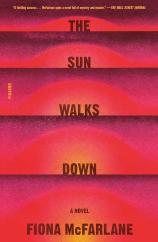The Sun Walks Down
Review
The Sun Walks Down
The disappearance of a young boy anchors THE SUN WALKS DOWN, Fiona McFarlane’s poetic and multilayered account of life in a remote part of colonial Australia.
It’s September 1883, and six-year-old Denny Wallace’s mother has sent him out to gather eggs. A sudden dust storm descends, and the boy gets lost trying to walk home. The unexpected event stirs the small community of Fairly into action. People fan out across the arid, rocky Willochra Plain in search of the missing child. The crisis exposes the fault lines between husbands and wives, parents and children, struggling farmers and wealthy landowners, and the native Australians and the settlers who have descended on a harsh land they seem unable (or unwilling) to understand.
Told in effortlessly shifting perspectives, THE SUN WALKS DOWN features a large cast of memorable, finely drawn characters. There’s newly married constable Robert Manning, who leads the initial search for Denny. But he’d much rather be in bed with his wife, Minna, who is waiting restlessly at home for her husband to return. Denny’s impatient 15-year-old sister, Cissy, welcomes the opportunity to take charge in a crisis. She feels she “was made to do” and can’t understand those who don’t take action, especially “all these women with eyes and legs who would be out looking for Denny and aren’t --- what’s the point of that?”
"Through characters such as Joanna, Billy and others, McFarlane offers a fresh take on the familiar tale of a missing child and adds new voices and depth to stories of a country’s pioneer past."
Mr. Daniels, Fairly’s hapless vicar, awkwardly inserts himself into the investigation. Billy Rough, Mathew Wallace’s Aboriginal farmhand, draws on his knowledge of the region as he heads out to hunt for his employer’s missing child. What the settlers see as “an empty wasteland…he knows to be dense with motion, the motion of ancestors, spirits, the animals that should be here and the animals that shouldn’t.” The arrogant Sergeant Foster, a policeman from Port Augusta, arrives, intending to take charge. He’s full of “courtly petulance” and brings with him a host of predictably colonialist ideas. As the author of several books with titles such as “Customs of the Central Australian Aborigines,” he views the situation with the eye of someone who plans to later turn it into a narrative with himself as the hero.
We also meet Karl Rapp, a Swedish artist passing through the area. He’s accompanied by his practical English wife Bess, an artist herself, though her talent doesn’t match that of her husband. Instead, she is able to skillfully and subtly arrange life in a way that smooths out difficulties for her spouse. The book’s title comes from one of Karl’s observations on the area’s “lurid” and unnerving sunsets (caused, he later learns, by the recent eruption of Krakatoa). That leads him to reflect on issues of language and translation. “The sun doesn’t set in Swedish, it walks down,” he notes. “So much more activity in his first language, seeing, walking!”
THE SUN WALKS DOWN is a compelling and unsentimental look at Australia in the 19th century. Inevitably, it recalls Joan Lindsay’s 1967 novel, PICNIC AT HANGING ROCK, along with Peter Weir’s 1975 film adaptation. Unlike the strange vanishing of the schoolgirls in Lindsay’s book, there’s no hint of the supernatural in Denny’s disappearance, though there is something haunting about the landscape McFarlane describes, with its hidden gorges and abandoned settlements. Denny, though he is the child of white parents, has a nonlinear sense of time more in tune with that of indigenous Australians. “There was no time when these things weren’t happening: burning, falling, walking, finding,” Denny thinks as he wanders alone in the bush. “Everything happened always, all at once.”
Denny’s disappearance occurs against a backdrop of the forced erasure of an entire way of life in the face of encroaching European settlement. The latter is a vanishing that the book’s white characters either don’t notice or hope to hurry along. There’s also the matter of Aboriginal children who are lost to white “civilization” efforts, including a mixed-race child who appears late in the novel and is adopted by his Anglo relatives. Amid the all-out search for Denny, the equally devastating loss of these other children goes mostly unremarked on by the book’s characters.
At one point, Joanna, the wealthy widow of an eccentric rancher, becomes fixated on a native tracker’s cloak, an intricate garment made of dozens of possum skins. She immediately recognizes its power, which she craves for herself. “How must it feel, she wonders, to own such a thing, to wield its authority, to wear it as a shield and trophy?.... It’s warm with the quick, beating life of a living thing,” she thinks. Joanna is in many ways an astute observer. She immediately sees through Foster’s conceited self-regard and realizes he can be managed with some careful ego stroking. (Later, Billy performs a similar dance with Foster during a tense game of cricket.) But Joanna doesn’t understand that the cloak represents something that can’t be bought, thus betraying her fundamental lack of understanding of the place she calls home and the people who lived there for centuries before those like her arrived.
Through characters such as Joanna, Billy and others, McFarlane offers a fresh take on the familiar tale of a missing child and adds new voices and depth to stories of a country’s pioneer past.
Reviewed by Megan Elliott on February 18, 2023
The Sun Walks Down
- Publication Date: February 13, 2024
- Genres: Fiction
- Paperback: 352 pages
- Publisher: Picador
- ISBN-10: 1250321751
- ISBN-13: 9781250321756




